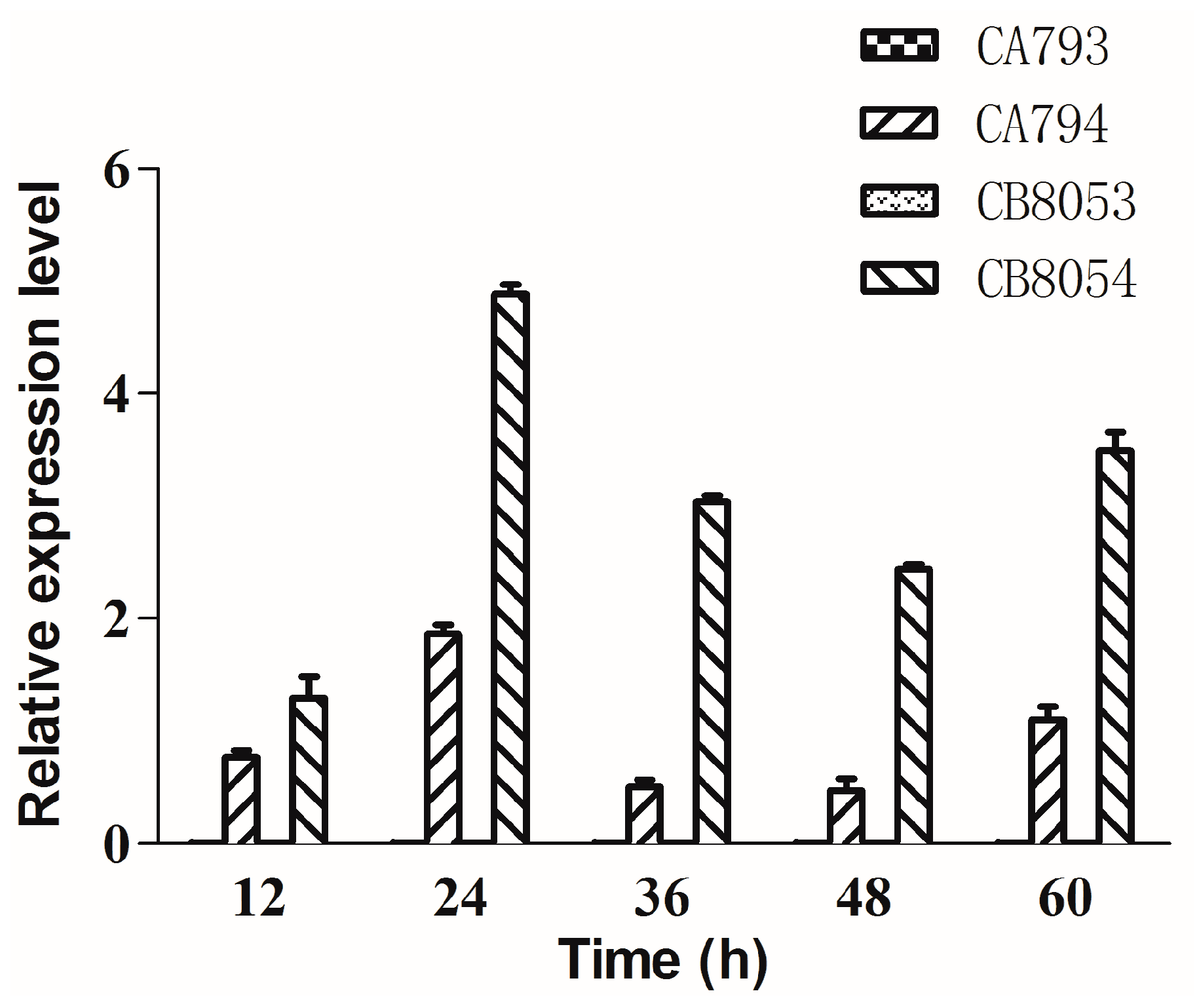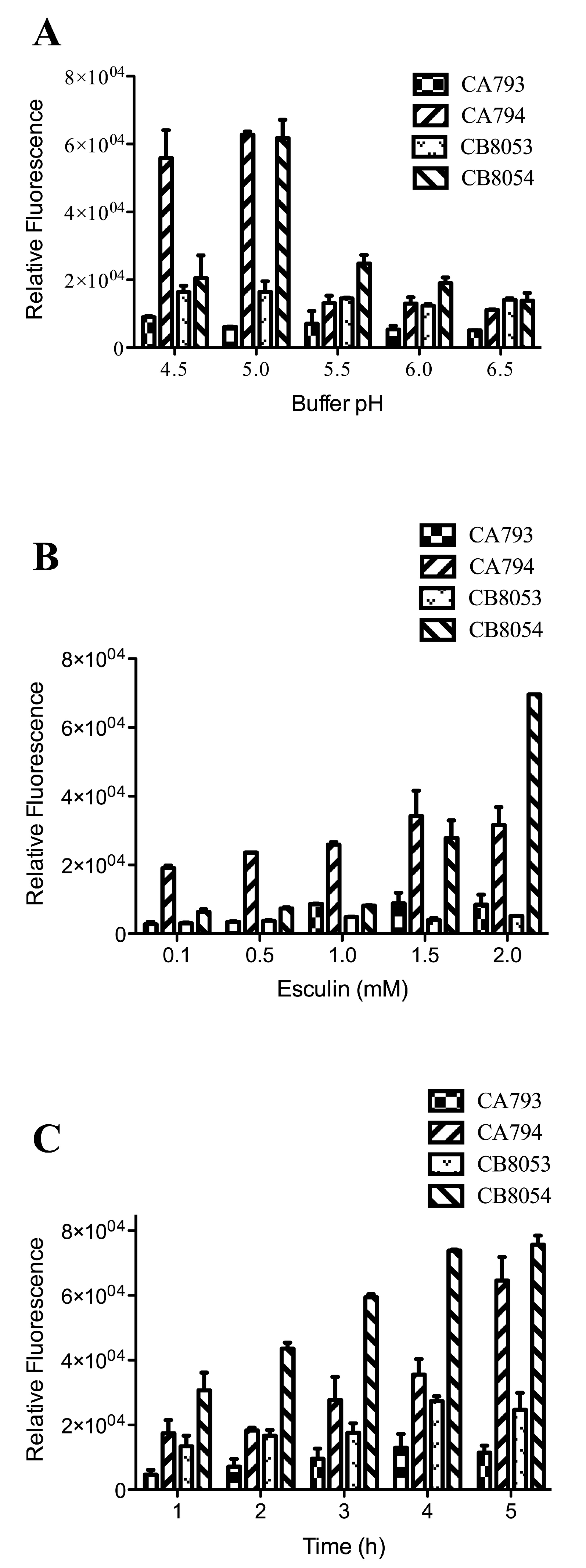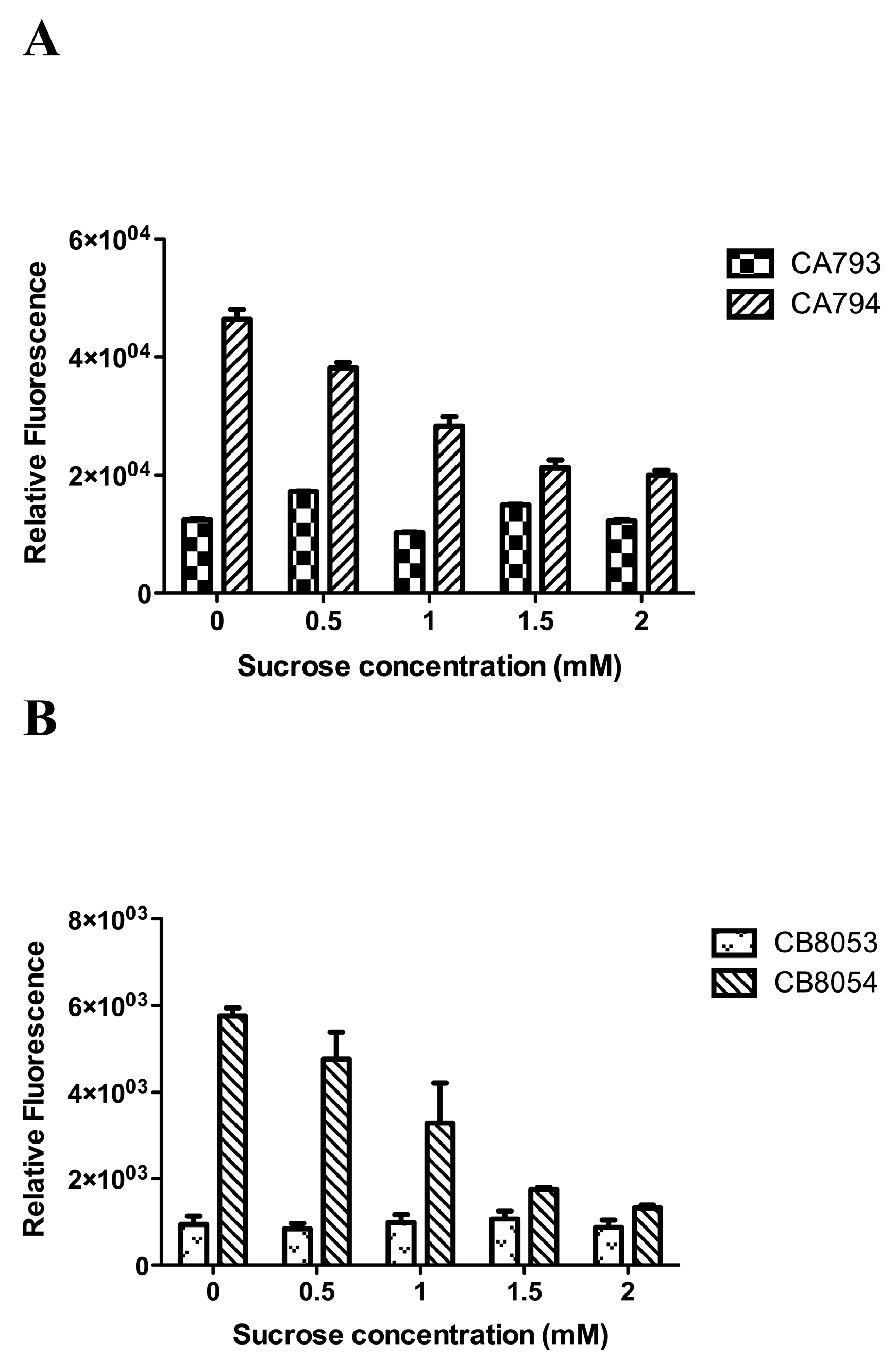A Convenient Fluorescence-Based Assay for the Detection of Sucrose Transport and the Introduction of a Sucrose Transporter from Potato into Clostridium Strains
Abstract
:1. Introduction
2. Results
2.1. Heterologous Expression of the StSUT1 Gene in C. beijerinckii and C. acetobutylicum
2.2. Determination of the Activity of the Sucrose Transporter StSUT1 by a Fluorescence-Based Assay
2.3. Sucrose Competition Effect on the Transport System
3. Discussion
4. Materials and Methods
4.1. Bacterial Strains and Plasmids
4.2. Media and Culture Conditions
4.3. Strain Construction
4.4. Real-Time Quantitative PCR Analysis
4.5. Transport Assays
Author Contributions
Funding
Acknowledgments
Conflicts of Interest
References
- Lee, S.H.; Yun, E.J.; Kim, J.; Lee, S.J.; Um, Y.; Kim, K.H. Biomass, strain engineering, and fermentation processes for butanol production by solventogenic clostridia. Appl. Microbiol. Biotechnol. 2016, 100, 8255–8271. [Google Scholar] [CrossRef] [PubMed]
- Wackett, L.P. Biomass to fuels via microbial transformations. Curr. Opin. Chem. Biol. 2008, 12, 187–193. [Google Scholar] [CrossRef] [PubMed]
- Qi, X.; Zha, J.; Liu, G.G.; Zhang, W.; Li, B.Z.; Yuan, Y.J. Heterologous xylose isomerase pathway and evolutionary engineering improve xylose utilization in Saccharomyces cerevisiae. Front. Microbiol. 2015, 6, 1165–1176. [Google Scholar] [CrossRef] [PubMed]
- Ren, C.; Chen, T.; Zhang, J.; Liang, L.; Lin, Z. An evolved xylose transporter from Zymomonas mobilis enhances sugar transport in Escherichia coli. Microb. Cell Factories 2009, 8, 1–9. [Google Scholar] [CrossRef] [PubMed]
- Meadow, N.D.; Rosenberg, J.M.; Pinkert, H.M.; Roseman, S. Sugar transport by the bacterial phosphotransferase system. Evidence that crr is the structural gene for the Salmonella typhimurium glucose-specific phosphocarrier protein IIIGlc. J. Biol. Chem. 1982, 257, 14538–14542. [Google Scholar] [PubMed]
- Riesmeier, J.W.; Willmitzer, L.; Frommer, W.B. Isolation and characterization of a sucrose carrier cDNA from spinach by functional expression in yeast. EMBO J. 1992, 11, 4705–4713. [Google Scholar] [CrossRef] [PubMed]
- Young, E.; Poucher, A.; Comer, A.; Bailey, A.; Alper, H. Functional survey for heterologous sugar transport proteins, using Saccharomyces cerevisiae as a host. Appl. Environ. Microb. 2011, 77, 3311–3319. [Google Scholar] [CrossRef]
- Sauer, N.; Stadler, R. A sink-specific H+/monosaccharide co-transporter from Nicotiana tabacum: Cloning and heterologous expression in baker’s yeast. Plant. J. 2010, 4, 601–610. [Google Scholar] [CrossRef]
- Lv, H.; Li, J.; Wu, Y.; Garyali, S.; Wang, Y. Transporter and its engineering for secondary metabolites. Appl. Microbiol. Biotechnol. 2016, 100, 6119–6130. [Google Scholar] [CrossRef] [PubMed]
- Oh, E.J.; Kwak, S.; Kim, H.; Jin, Y.S. Transporter engineering for cellobiose fermentation under lower pH conditions by engineered Saccharomyces cerevisiae. Bioresour. Technol. 2017, 245, 1469–1475. [Google Scholar] [CrossRef]
- Marques, W.L.; Mans, R.; Henderson, R.K.; Marella, E.R.; Horst, J.T.; Hulster, E.D.; Poolman, B.; Daran, J.; Pronk, J.T.; Gombert, A.K.; et al. Combined engineering of disaccharide transport and phosphorolysis for enhanced ATP yield from sucrose fermentation in Saccharomyces cerevisiae. Metab. Eng. 2018, 45, 121–133. [Google Scholar] [CrossRef] [PubMed]
- Singh, R.; White, D.; Blum, P. Identification of the ATPase subunit of the primary maltose transporter in the hyperthermophilic anaerobe Thermotoga maritima. Appl. Environ. Microbiol. 2017, 83, e00930-17. [Google Scholar] [CrossRef] [PubMed]
- Singh, R.; White, D.; Demirel, Y.; Kelly, R.; Noll, K.; Blum, P. Uncoupling fermentative synthesis of molecular hydrogen from biomass formation in Thermotoga maritima. Appl. Environ. Microbiol. 2018, 84, e00998-18. [Google Scholar] [CrossRef] [PubMed]
- Feng, J.; Gu, Y.; Yan, P.; Song, C.; Wang, Y. Recruiting energy-conserving sucrose utilization pathways for enhanced 2,3-butanediol production in Bacillus subtilis. ACS Sustain. Chem. Eng. 2017, 5, 11221–11225. [Google Scholar] [CrossRef]
- Zhang, J.; Wang, P.; Wang, X.; Feng, J.; Sandhu, H.S.; Wang, Y. Enhancement of sucrose metabolism in Clostridium saccharoperbutylacetonicum N1-4 through metabolic engineering for improved acetone-butanol-ethanol (ABE) fermentation. Bioresour. Technol. 2018, 270, 430–438. [Google Scholar] [CrossRef] [PubMed]
- Sovonick, S.A.; Geiger, D.R.; Fellows, R.J. Evidence for active phloem loading in the minor veins of sugar beet. Plant. Physiol. 1974, 54, 886–891. [Google Scholar] [CrossRef]
- Schulz, A.; Beyhl, D.; Marten, I.; Wormit, A.; Neuhaus, E.; Poschet, G.; Büttner, M.; Schneider, S.; Sauer, N.; Hedrich, R. Proton-driven sucrose symport and antiport are provided by the vacuolar transporters SUC4 and TMT1/2. Plant. J. 2011, 68, 129–136. [Google Scholar] [CrossRef] [PubMed]
- Bush, D.R. Proton-coupled sucrose transport in plasmalemma vesicles isolated from sugar beet (Beta vulgaris L. cv Great Western) leaves. Plant. Physiol. 1989, 89, 1318–1323. [Google Scholar] [CrossRef]
- Reinders, A.; Sivitz, A.B.; Ward, J.M. Evolution of plant sucrose uptake transporters. Front. Plant. Sci. 2012, 3, 22–33. [Google Scholar] [CrossRef]
- Gora, P.J.; Reinders, A.; Ward, J.M. A novel fluorescent assay for sucrose transporters. Plant. Methods 2012, 8, 13–18. [Google Scholar] [CrossRef]
- Ndaba, B.; Chiyanzu, I.; Marx, S. N-Butanol derived from biochemical and chemical routes: A review. Biotechnol. Rep. 2015, 8, 1–9. [Google Scholar] [CrossRef] [PubMed]
- Dusséaux, S.; Croux, C.; Soucaille, P.; Meynial-Salles, I. Metabolic engineering of Clostridium acetobutylicum ATCC 824 for the high-yield production of a biofuel composed of an isopropanol/butanol/ethanol mixture. Metab.Eng. 2013, 18, 1–8. [Google Scholar] [CrossRef] [PubMed]
- Tangney, M.; Mitchell, W.J. Analysis of a catabolic operon for sucrose transport and metabolism in Clostridium acetobutylicum ATCC 824. J. Mol. Microbiol. Biotechnol. 2000, 2, 71–80. [Google Scholar] [PubMed]
- Yu, Y.; Tangney, M.; Aass, H.C.; Mitchell, W.J. Analysis of the mechanism and regulation of lactose transport and metabolism in Clostridium acetobutylicum ATCC 824. Appl. Environ. Microb. 2007, 73, 1842–1850. [Google Scholar] [CrossRef] [PubMed]
- Mitchell, W.J. Carbohydrate uptake and utilization by Clostridium beijerinckii NCIMB 8052. Anaerobe 1996, 2, 379–384. [Google Scholar] [CrossRef]
- Mitchell, W.J.; Albasheri, K.A.; Yazdanian, M. Factors affecting utilization of carbohydrates by Clostridia. FEMS Microbiol. Rev. 1995, 17, 317–329. [Google Scholar] [CrossRef]
- Tangney, M.; Rousse, C.; Yazdanian, M.; Mitchell, W.J. Note: Sucrose transport and metabolism in Clostridium beijerinckii NCIMB 8052. J. Appl. Microbiol. 1998, 84, 914–919. [Google Scholar] [CrossRef] [PubMed]
- Reid, S.J.; Rafudeen, M.S.; Leat, N.G. The genes controlling sucrose utilization in Clostridium beijerinckii NCIMB 8052 constitute an operon. Microbiology 1999, 145, 1461–1472. [Google Scholar] [CrossRef]
- Rottmann, T.M.; Fritz, C.; Lauter, A.; Schneider, S.; Fischer, C.; Danzberger, N.; Dietrich, P.; Sauer, N.; Stadler, R. Protoplast-esculin assay as a new method to assay plant sucrose transporters: Characterization of AtSUC6 and AtSUC7 sucrose uptake activity in Arabidopsis Col-0 ecotype. Front. Plant. Sci. 2018, 9, 430–451. [Google Scholar] [CrossRef]
- Riesmeier, J.W.; Hirner, B.; Frommer, W.B. Potato sucrose transporter expression in minor veins indicates a role in phloem loading. Plant. Cell 1993, 5, 1591–1598. [Google Scholar]
- Boorer, K.J.; Loo, D.D.; Frommer, W.B.; Wright, E.M. Transport mechanism of the cloned potato H+/sucrose cotransporter StSUT1. J. Biol. Chem. 1996, 271, 25139–25144. [Google Scholar] [CrossRef] [PubMed]
- Haus, S.; Jabbari, S.; Millat, T.; Janssen, H.; Fischer, R.R.; Bahl, H.; King, J.R.; Wolkenhauer, O. A systems biology approach to investigate the effect of pH-induced gene regulation on solvent production by Clostridium acetobutylicum in continuous culture. BMC Syst. Biol. 2011, 5, 10. [Google Scholar] [CrossRef] [PubMed]
- Jiang, M.; Chen, J.N.; He, A.Y.; Wu, H.; Kong, X.P.; Liu, J.L.; Yin, C.Y.; Chen, W.F.; Chen, P. Enhanced acetone/butanol/ethanol production by Clostridium beijerinckii IB4 using pH control strategy. Process. Biochem. 2014, 49, 1238–1244. [Google Scholar] [CrossRef]
- Malaviya, A.; Jang, Y.S.; Lee, S.Y. Continuous butanol production with reduced byproducts formation from glycerol by a hyper producing mutant of Clostridium pasteurianum. Appl. Microbiol. Biotechnol. 2012, 93, 1485–1494. [Google Scholar] [CrossRef] [PubMed]
- Chen, C.K.; Blaschek, H.P. Effect of acetate on molecular and physiological aspects of Clostridium beijerinckii NCIMB 8052 solvent production and strain degeneration. Appl. Environ. Microb. 1999, 65, 499–505. [Google Scholar]
- Girbal, L.; von Abendroth, G.; Winkler, M.; Benton, P.M.; Meynial-Salles, I.; Croux, C.; Peters, J.W.; Happe, T.; Soucaille, P. Homologous and heterologous overexpression in Clostridium acetobutylicum and characterization of purified clostridial and algal Fe-only hydrogenases with high specific activities. Appl. Environ. Microb. 2005, 71, 2777–2781. [Google Scholar] [CrossRef]
- Mermelstein, L.D.; Papoutsakis, E.T. In vivo methylation in Escherichia coli by the Bacillus subtilis phage phi 3T I methyltransferase to protect plasmids from restriction upon transformation of Clostridium acetobutylicum ATCC 824. Appl. Environ. Microb. 1993, 59, 1077–1081. [Google Scholar]
- Tummala, S.B.; Welker, N.E.; Papoutsakis, E.T. Design of antisense RNA constructs for downregulation of the acetone formation pathway of Clostridium acetobutylicum. J. Bacteriol. 2003, 185, 1923–1934. [Google Scholar] [CrossRef]
- Mermelstein, L.D.; Welker, N.E.; Bennett, G.N.; Papoutsakis, E.T. Expression of cloned homologous fermentative genes in Clostridium acetobutylicum ATCC 824. Bio/Technology 1992, 10, 190–195. [Google Scholar] [CrossRef]
Sample Availability: Samples of the microbial strains are available from the authors. |



© 2019 by the authors. Licensee MDPI, Basel, Switzerland. This article is an open access article distributed under the terms and conditions of the Creative Commons Attribution (CC BY) license (http://creativecommons.org/licenses/by/4.0/).
Share and Cite
Zhang, Z.; Lin, L.; Tang, H.; Zeng, S.; Guo, Y.; Wei, Y.; Huang, R.; Pang, H.; Du, L. A Convenient Fluorescence-Based Assay for the Detection of Sucrose Transport and the Introduction of a Sucrose Transporter from Potato into Clostridium Strains. Molecules 2019, 24, 3495. https://doi.org/10.3390/molecules24193495
Zhang Z, Lin L, Tang H, Zeng S, Guo Y, Wei Y, Huang R, Pang H, Du L. A Convenient Fluorescence-Based Assay for the Detection of Sucrose Transport and the Introduction of a Sucrose Transporter from Potato into Clostridium Strains. Molecules. 2019; 24(19):3495. https://doi.org/10.3390/molecules24193495
Chicago/Turabian StyleZhang, Zhikai, Lihua Lin, Hongchi Tang, Shaowei Zeng, Yuan Guo, Yutuo Wei, Ribo Huang, Hao Pang, and Liqin Du. 2019. "A Convenient Fluorescence-Based Assay for the Detection of Sucrose Transport and the Introduction of a Sucrose Transporter from Potato into Clostridium Strains" Molecules 24, no. 19: 3495. https://doi.org/10.3390/molecules24193495




